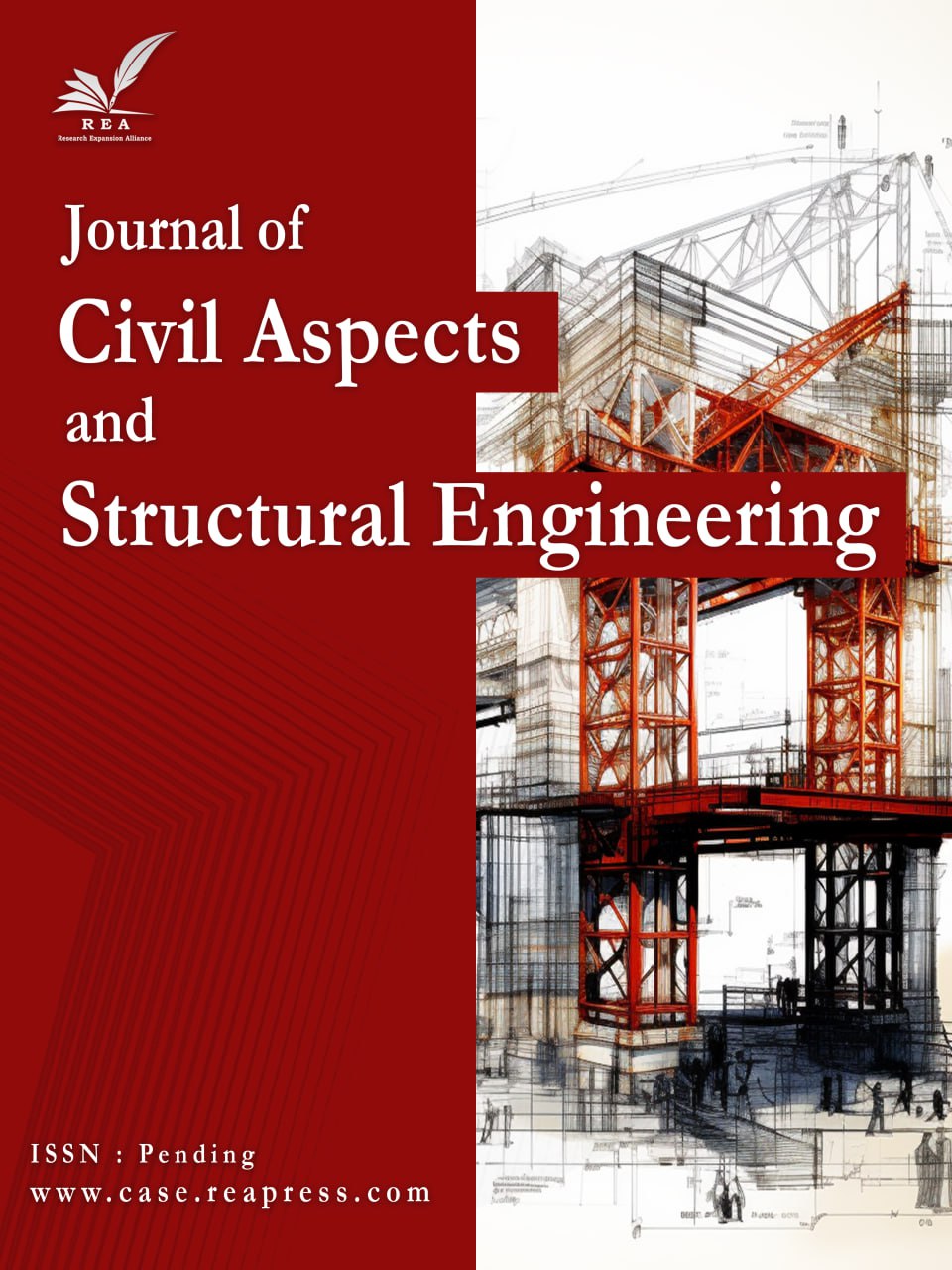Enhancing the Mechanical Properties of Sawdust Concrete with Silica Fume, Metakaolin, and Marble Powder
Abstract
This research explores the innovative use of sawdust as a sustainable aggregate in concrete, addressing both environmental and structural challenges. The study investigates the effects of incorporating sawdust at varying proportions (15%, 25%, and 35%) into concrete mixtures, aiming to reduce carbon emissions and promote lightweight construction. Recognizing the negative impact of Waste Glass Powder (WGP) on concrete strength, this research introduces Silica Fume (SF), Metakaolin (MK), and Marble Powder (MP) as potential additives to enhance the compressive strength and reduce the specific weight of sawdust concrete. The experimental program involved 13 concrete mixtures, with SF, MK, and MP added at 5%, 10%, and 15% by mass to a 25% sawdust mix. Results indicate that increasing sawdust content significantly decreases compressive strength, with reductions from 31.655 MPa in the control to 6.291 MPa at 35% sawdust. However, the addition of SF and MK notably improved strength, with SF enhancing it by 68.8% at 10% addition and MK by 69.3% at 5%. MP, while less effective, still increased strength by 42.9%. Sawdust addition consistently reduced concrete density, from 2399 kg/m³ in the control to 2091 kg/m³ at 35% sawdust. SF further reduced density, whereas MK and MP increased it. The study concludes that 10% SF or 5% MK are optimal for improving sawdust concrete properties, offering a balance of enhanced strength and reduced weight. This research contributes to sustainable construction practices by demonstrating the viability of sawdust and specific additives in creating environmentally friendly, lightweight concrete solutions.
Keywords:
Sawdust Concrete, Compressive Strength, Silica Fume, Metakaolin, Marble PowderReferences
- [1] Zaleska, M., Pavlikova, M., Pokorny, J., Jankovsky, O., Pavlik, Z., & Cerny, R. (2018). Structural, mechanical and hygrothermal properties of lightweight concrete based on the application of waste plastics. Construction and building materials, 180, 1-11. https://doi.org/10.1016/j.conbuildmat.2018.05.250
- [2] Pournoori, P., Davarpanah TQ, A., Rajaee, A., Ghodratnama, M., Abrishami, S., & Masoodi, A. R. (2024). Experimental exploration of fracture behavior (pure mode III) in eco-friendly steel fiber-reinforced self-compacting concrete with waste tempered glass as coarse aggregates. Scientific reports, 14(1), 9043. https://doi.org/10.1038/s41598-024-58912-z
- [3] Colangelo, F., Cioffi, R., Liguori, B., & Iucolano, F. (2016). Recycled polyolefins waste as aggregates for lightweight concrete. Composites part B: engineering, 106, 234–241. https://doi.org/10.1016/j.compositesb.2016.09.041
- [4] Alengaram, U. J., Al Muhit, B. A., & bin Jumaat, M. Z. (2013). Utilization of oil palm kernel shell as lightweight aggregate in concrete-A review. Construction and building materials, 38, 161–172. https://doi.org/10.1016/j.conbuildmat.2012.08.026
- [5] Demirboga, R., Örüng, İ., & Gül, R. (2001). Effects of expanded perlite aggregate and mineral admixtures on the compressive strength of low-density concretes. Cement and concrete research, 31(11), 1627-1632. https://doi.org/10.1016/S0008-8846(01)00615-9
- [6] Ganiron, T. U. (2014). Effect of sawdust as fine aggregate in concrete mixture for building construction. International journal of advanced science and technology, 63(1), 73–82. http://dx.doi.org/10.14257/ijast.2014.63.07
- [7] Miri, H., Rajaee, A., Ghodratnama, M., Quchan, A. D. T., Sheikhi, M., & Pournoori, P. (2024). Sustainable building technology and urban development. International journal of sustainable building technology and urban development, 15(3), 307–327. https://doi.org/10.22712/susb.20240023
- [8] Farahinia, E., Sheikhi, M., Amirhossein, D. T. Q., Rajaee, A., Ghodratnama, M., Banihashem, S. M., & Pournoori, P. (2024). Experimental and numerical exploration of mechanical properties of sawdust concrete due to the addition of waste glass powder. International journal of sustainable building technology and urban development, 15(3), 328–353. https://doi.org/10.22712/susb.20240024
- [9] Sawant, A., Sharma, A., Rahate, R., Mayekar, N., & Ghadge, M. D. (2018). Partial replacement of sand with sawdust in concrete. International research journal of engineering and technology, 5(3), 3098–3101. https://www.academia.edu/download/56787339/IRJET-V5I3732.pdf
- [10] Orozco, C., Tangtermsirikul, S., Sugiyama, T., & Babel, S. (2023). Examining the endpoint impacts, challenges, and opportunities of fly ash utilization for sustainable concrete construction. Scientific reports, 13(1), 18254. https://doi.org/10.1038/s41598-023-45632-z
- [11] Amirnia, M., Sheikhi, M., Talebi, N., Pournoori, P., & Rajaee, A. (2024). Evaluation of hardened properties of structural concrete containing waste tiles and volcanic ash. International congress on engineering, technology & applied sciences. ETAS. https://l1nq.com/dyJsj
- [12] Kumar, R. (2023). Effect of metakaolin on mechanical characteristics of the mortar and concrete: A critical review. Materials today: proceedings, 93, 315–319. https://doi.org/10.1016/j.matpr.2023.07.262
- [13] Baradaran, M. S., Qazanfari, R., & Baradaran, S. (2023). Study of soil reinforcement in the east of Mashhad using glass granule. Materials research express, 10(5), 55202. https://doi.org/10.1088/2053-1591/acd5af
- [14] Rajaee, A., Baridjavan, S., Sheikhi, M., & Pournoori, P. (2023). Glass powder and pvc granules as partial replacement of cement and aggregate; an experimental study. 7th International conference on applied researches in science and engineering. Aachen, Germany. Civilica. (pp. 1–12). https://en.civilica.com/doc/1682098/
- [15] Hamada, H. M., Abed, F., Katman, H. Y. B., Humada, A. M., Al Jawahery, M. S., Majdi, A., … & Thomas, B. S. (2023). Effect of silica fume on the properties of sustainable cement concrete. Journal of materials research and technology, 24, 8887–8908. https://doi.org/10.1016/j.jmrt.2023.05.147
- [16] Prakash, B., Saravanan, T. J., Kabeer, K. I. S. A., & Bisht, K. (2023). Exploring the potential of waste marble powder as a sustainable substitute to cement in cement-based composites: A review. Construction and building materials, 401, 132887. https://doi.org/10.1016/j.conbuildmat.2023.132887
- [17] Baradaran, S., Rahimi, J., Ameri, M., & Maleki, A. (2024). Mechanical performance of asphalt mixture containing eco-friendly additive by recycling PET. Case studies in construction materials, 20, e02740. https://doi.org/10.1016/j.cscm.2023.e02740
- [18] Baradaran, S., Aliha, M. R. M., Maleki, A., & Underwood, B. S. (2024). Fracture properties of asphalt mixtures containing high content of reclaimed asphalt pavement (RAP) and eco-friendly PET additive at low temperature. Construction and building materials, 449, 138426. https://doi.org/10.1016/j.conbuildmat.2024.138426
- [19] Siddique, R., Singh, M., Mehta, S., & Belarbi, R. (2020). Utilization of treated saw dust in concrete as partial replacement of natural sand. Journal of cleaner production, 261, 121226. https://doi.org/10.1016/j.jclepro.2020.121226
- [20] Ahmed, W., Khushnood, R. A., Memon, S. A., Ahmad, S., Baloch, W. L., & Usman, M. (2018). Effective use of sawdust for the production of eco-friendly and thermal-energy efficient normal weight and lightweight concretes with tailored fracture properties. Journal of cleaner production, 184, 1016–1027. https://doi.org/10.1016/j.jclepro.2018.03.009
- [21] Cheng, Y., You, W., Zhang, C., Li, H., & Hu, J. (2013). The implementation of waste sawdust in concrete. Engineering, 5(12), 943. http://dx.doi.org/10.4236/eng.2013.512115
- [22] Oyedepo, O. J., Oluwajana, S. D., & Akande, S. P. (2014). Investigation of properties of concrete using sawdust as partial replacement for sand. Civil and environmental research, 6(2), 35–42. https://core.ac.uk/download/pdf/234677724.pdf
- [23] Osei, D. Y., & Jackson, E. N. (2016). Compressive strength of concrete using sawdust as aggregate. International journal of scientific & engineering research, 7(4), 1349–1353. https://www.ijser.org/researchpaper/compressive-strength-of-concrete-using-sawdust-as-aggregate.pdf
- [24] Olutoge, F. A. (2010). Investigations on sawdust and palm kernel shells as aggregate replacement. ARPN journal of engineering and applied sciences, 5(4), 7–13. https://www.academia.edu/download/96331661/jeas_0410_319.pdf
- [25] Standard, A. (2009). Standard specification for portland cement. ASTM international west Conshohocken. https://www.astm.org/standards/c150
- [26] American society for testing materials. Committee C-9 on concrete and concrete aggregates. (2011). Standard specification for silica fume used in cementitious mixtures. ASTM international. https://l1nq.com/7KfKN
- [27] Hameed, M. S., Sekar, A. S. S., & Saraswathy, V. (2012). Strength and permeability characteristics study of self-compacting concrete using crusher rock dust and marble sludge powder. Arabian journal for science and engineering, 37, 561–574. https://doi.org/10.1007/s13369-012-0201-x
- [28] Afshoon, I., Miri, M., & Mousavi, S. R. (2023). Comprehensive experimental and numerical modeling of strength parameters of eco-friendly steel fiber reinforced SCC containing coarse copper slag aggregates. Construction and building materials, 367, 130304. https://doi.org/10.1016/j.conbuildmat.2023.130304
- [29] British standard. (1983). Testing concrete: method for determination of compressive strength of concrete cubes. https://dl.azmanco.com/standards/BS/BS 1881-Part 116-83.pdf


